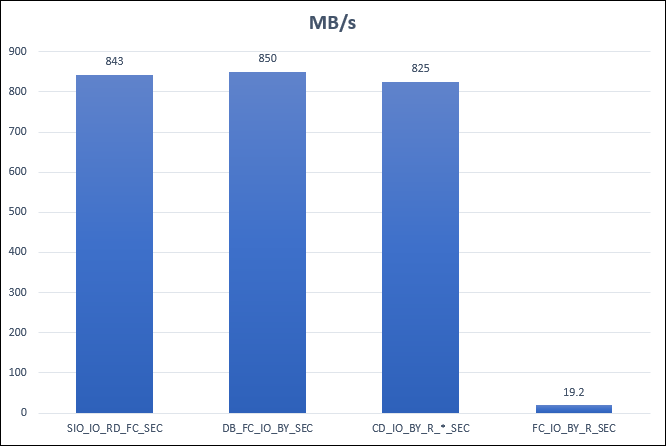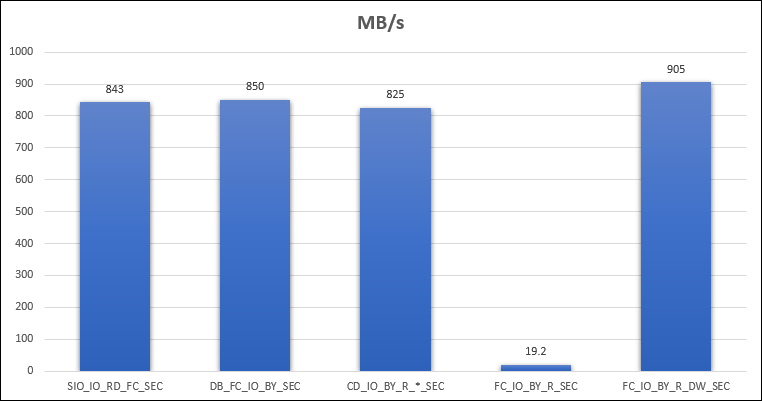Understand metrics for Exadata Storage Server is important to understand how all the software features are being used and all the details from that. Here I will discuss one case where the FC_IO_BY_R_SEC metric can show not precise values. And I will discuss one missing metric that can save a lot.
If you have doubts about metrics, you can check my post about metrics, it was an introduction, but cover some aspects of how to read and use it. You can check my other post where I show how to use metric DB_FC_IO_BY_SEC to identify database problems that can be hidden when checking only from the database side.
Metrics collection
For this post, all metrics were collected from one storage server, but the behavior occurs in all cells from Exadata, and in all versions. And they were collected using the same timestamp be accurate. So, they represent one minute, but again, the same behavior that I show here occurs every time. When reading the metrics, please look at the metric name and the collect moment.
The idea for this post came when I was investigating storage usage from one database to see if we are hitting the limits for Exadata Storage. I needed to check disk, flash cache, and other details. For the behavior I show below, I already worked with Oracle about (SR, BUG, ER).
DB_FC_IO_BY_SEC
I already discussed about this metric in a previous post, but its report (according to the official doc) the “The number of megabytes of I/O per second for this database to flash cache”. Look the usage for the database DBPR1_EXA:
CellCLI> list metrichistory where collectionTime > '2019-12-13T15:42:00+01:00' and collectionTime < '2019-12-13T15:43:00+01:00'
and name = 'DB_FC_IO_BY_SEC' and metricObjectName like 'DBPR1_EXA'
DB_FC_IO_BY_SEC DBPR1_EXA 850 MB/sec 2019-12-13T15:42:03+01:00
CellCLI>
As you can see, at 15:42:03 of 2019-12-13 the storage server reported that during the last minute this database made around 850 MB/s of reading from flash cache.
And this was the highest database consumption (that used more than 0.5 MB/s):
CellCLI> list metrichistory where collectionTime > '2019-12-13T15:42:00+01:00' and collectionTime < '2019-12-13T15:43:00+01:00'
and name like 'DB_.*BY.*SEC' and metricvalue > 0.5
DB_FC_IO_BY_SEC ORADB01P 1 MB/sec 2019-12-13T15:42:03+01:00
DB_FC_IO_BY_SEC ORADB02P 7 MB/sec 2019-12-13T15:42:03+01:00
DB_FC_IO_BY_SEC ORADB01V 1 MB/sec 2019-12-13T15:42:03+01:00
DB_FC_IO_BY_SEC ORADB03P 5 MB/sec 2019-12-13T15:42:03+01:00
DB_FC_IO_BY_SEC ORAD01P 6 MB/sec 2019-12-13T15:42:03+01:00
DB_FC_IO_BY_SEC ORADBPR_EXA 2 MB/sec 2019-12-13T15:42:03+01:00
DB_FC_IO_BY_SEC DBPR1_EXA 850 MB/sec 2019-12-13T15:42:03+01:00
DB_FC_IO_BY_SEC DBP01 104 MB/sec 2019-12-13T15:42:03+01:00
DB_FD_IO_BY_SEC ORADB01P 1 MB/sec 2019-12-13T15:42:03+01:00
DB_FD_IO_BY_SEC ORADB02P 7 MB/sec 2019-12-13T15:42:03+01:00
DB_FD_IO_BY_SEC ORADB01V 1 MB/sec 2019-12-13T15:42:03+01:00
DB_FD_IO_BY_SEC ORADB03P 5 MB/sec 2019-12-13T15:42:03+01:00
DB_FD_IO_BY_SEC ORAD01P 6 MB/sec 2019-12-13T15:42:03+01:00
DB_FD_IO_BY_SEC ORADBPR_EXA 2 MB/sec 2019-12-13T15:42:03+01:00
DB_FD_IO_BY_SEC DBPR1_EXA 850 MB/sec 2019-12-13T15:42:03+01:00
DB_FD_IO_BY_SEC DBP01 105 MB/sec 2019-12-13T15:42:03+01:00
DB_FD_IO_BY_SEC _OTHER_DATABASE_ 1 MB/sec 2019-12-13T15:42:03+01:00
DB_FL_IO_BY_SEC DBP01 1.150 MB/sec 2019-12-13T15:42:03+01:00
DB_IO_BY_SEC ORAD01P 2 MB/sec 2019-12-13T15:42:03+01:00
DB_IO_BY_SEC ORADB1P_EXA 1 MB/sec 2019-12-13T15:42:03+01:00
DB_IO_BY_SEC DBP01 2 MB/sec 2019-12-13T15:42:03+01:00
CellCLI>
If I sum all the database usage from flash cache, it will be around 950 MB/s.
FC_IO_BY_R_SEC
Since DB_FC_IO_BY_SEC reported just a small usage, I went to check the metric for the whole flash cache. So, I went to FC_IO_BY_R_SEC since this metric report (according to the docs): “The number of megabytes read per second from flash cache”. And since we are reading the metrics for flash cache direct, it report the number for all databases.
But, look at the numbers:
CellCLI> list metrichistory where collectionTime > '2019-12-13T15:42:00+01:00' and collectionTime < '2019-12-13T15:43:00+01:00'
and name = 'FC_IO_BY_R_SEC';
FC_IO_BY_R_SEC FLASHCACHE 19.343 MB/sec 2019-12-13T15:42:03+01:00
CellCLI>
So, at the same time moment that one database metric reported around 850 MB/s from FC reading, the metrics from FC reported around 19 MB/s. Something it is not correct.
And even if I check the minute before and after (because maybe was a glimpse of time collection) the numbers are not quite different:
CellCLI> list metrichistory where collectionTime > '2019-12-13T15:41:00+01:00' and collectionTime < '2019-12-13T15:44:00+01:00'
and name = 'FC_IO_BY_R_SEC';
FC_IO_BY_R_SEC FLASHCACHE 27.519 MB/sec 2019-12-13T15:41:03+01:00
FC_IO_BY_R_SEC FLASHCACHE 19.343 MB/sec 2019-12-13T15:42:03+01:00
FC_IO_BY_R_SEC FLASHCACHE 39.600 MB/sec 2019-12-13T15:43:03+01:00
CellCLI>
Others flash metrics
So, since the numbers appear to be completely wrong I searched for other metrics that report flash usage (disks and flash cache as an example).
CD_IO_BY_*_*_SEC
I started to search with the lowest level possible, going directly to the celldisk metrics. For that I used CD_IO_BY_R_LG_SEC, CD_IO_BY_R_SM_SEC (for reads), CD_IO_BY_W_LG_SEC, and CD_IO_BY_W_SM_SEC (for writes). Basically, it reports: “The rate which is the number of megabytes read in large blocks per second from a cell disk”.
Filtering just from flash disks type I had this numbers:
CellCLI> list metrichistory where collectionTime > '2019-12-13T15:42:00+01:00' and collectionTime < '2019-12-13T15:43:00+01:00'
and name like 'CD_IO_BY.*SEC.*' and metricobjectname like 'FD_.*' and metricvalue > 0
CD_IO_BY_R_LG_SEC FD_00_exastradm01 179 MB/sec 2019-12-13T15:42:03+01:00
CD_IO_BY_R_LG_SEC FD_01_exastradm01 296 MB/sec 2019-12-13T15:42:03+01:00
CD_IO_BY_R_LG_SEC FD_02_exastradm01 200 MB/sec 2019-12-13T15:42:03+01:00
CD_IO_BY_R_LG_SEC FD_03_exastradm01 250 MB/sec 2019-12-13T15:42:03+01:00
CD_IO_BY_R_SM_SEC FD_00_exastradm01 3.161 MB/sec 2019-12-13T15:42:03+01:00
CD_IO_BY_R_SM_SEC FD_01_exastradm01 3.152 MB/sec 2019-12-13T15:42:03+01:00
CD_IO_BY_R_SM_SEC FD_02_exastradm01 2.990 MB/sec 2019-12-13T15:42:03+01:00
CD_IO_BY_R_SM_SEC FD_03_exastradm01 3.741 MB/sec 2019-12-13T15:42:03+01:00
CD_IO_BY_W_LG_SEC FD_00_exastradm01 0.859 MB/sec 2019-12-13T15:42:03+01:00
CD_IO_BY_W_LG_SEC FD_01_exastradm01 1.125 MB/sec 2019-12-13T15:42:03+01:00
CD_IO_BY_W_LG_SEC FD_02_exastradm01 1.028 MB/sec 2019-12-13T15:42:03+01:00
CD_IO_BY_W_LG_SEC FD_03_exastradm01 0.801 MB/sec 2019-12-13T15:42:03+01:00
CD_IO_BY_W_SM_SEC FD_00_exastradm01 0.982 MB/sec 2019-12-13T15:42:03+01:00
CD_IO_BY_W_SM_SEC FD_01_exastradm01 0.998 MB/sec 2019-12-13T15:42:03+01:00
CD_IO_BY_W_SM_SEC FD_02_exastradm01 1.006 MB/sec 2019-12-13T15:42:03+01:00
CD_IO_BY_W_SM_SEC FD_03_exastradm01 0.937 MB/sec 2019-12-13T15:42:03+01:00
CellCLI>
As you can see, just picking up the CD_IO_BY_R_LG_SEC I got around 925 MB/s, a close number from the same that I got from the database metric reading the flash. Another hint from that says to me that reads are requesting more than 128KB for each access since they were counted as large (LG).
FL_IO_DB_BY_W_SEC and FL_IO_FL_BY_W_SEC
Since I was checking for a bad flash report, I checked the flash log metrics but they reported close values from cell disk metrics:
CellCLI> list metrichistory where collectionTime > '2019-12-13T15:42:00+01:00' and collectionTime < '2019-12-13T15:43:00+01:00'
and name like 'FL_IO.*_SEC'
FL_IO_DB_BY_W_SEC FLASHLOG 1.974 MB/sec 2019-12-13T15:42:03+01:00
FL_IO_FL_BY_W_SEC FLASHLOG 2.673 MB/sec 2019-12-13T15:42:03+01:00
CellCLI>
So, the metrics for disk usage, was OK, reporting correct values.
SIO_IO_RD_FC_SEC
As you can see, the metrics from database usage from flash cache are reporting the same values that were possible to check from the closest as from hardware report (celldisk). So, maybe could be a software misreading in-memory values.
Because of that, I checked from other metrics that can report form features that interact with flash cache. So, I checked from Smart I/O:
CellCLI> list metrichistory where collectionTime > '2019-12-13T15:42:00+01:00' and collectionTime < '2019-12-13T15:43:00+01:00'
and name like 'SIO_.*SEC.*'
SIO_IO_EL_OF_SEC SMARTIO 1,223 MB/sec 2019-12-13T15:42:03+01:00
SIO_IO_OF_RE_SEC SMARTIO 34.688 MB/sec 2019-12-13T15:42:03+01:00
SIO_IO_PA_TH_SEC SMARTIO 0.000 MB/sec 2019-12-13T15:42:03+01:00
SIO_IO_RD_FC_HD_SEC SMARTIO 0.174 MB/sec 2019-12-13T15:42:03+01:00
SIO_IO_RD_FC_SEC SMARTIO 843 MB/sec 2019-12-13T15:42:03+01:00
SIO_IO_RD_HD_SEC SMARTIO 0.101 MB/sec 2019-12-13T15:42:03+01:00
SIO_IO_RD_RQ_FC_HD_SEC SMARTIO 0.183 IO/sec 2019-12-13T15:42:03+01:00
SIO_IO_RD_RQ_FC_SEC SMARTIO 850 IO/sec 2019-12-13T15:42:03+01:00
SIO_IO_RD_RQ_HD_SEC SMARTIO 0.000 IO/sec 2019-12-13T15:42:03+01:00
SIO_IO_RV_OF_SEC SMARTIO 3.392 MB/sec 2019-12-13T15:42:03+01:00
SIO_IO_SI_SV_SEC SMARTIO 362 MB/sec 2019-12-13T15:42:03+01:00
SIO_IO_WR_FC_SEC SMARTIO 0.008 MB/sec 2019-12-13T15:42:03+01:00
SIO_IO_WR_HD_SEC SMARTIO 0.000 MB/sec 2019-12-13T15:42:03+01:00
SIO_IO_WR_RQ_FC_SEC SMARTIO 0.017 IO/sec 2019-12-13T15:42:03+01:00
SIO_IO_WR_RQ_HD_SEC SMARTIO 0.000 IO/sec 2019-12-13T15:42:03+01:00
CellCLI>
And as you can see the SIO_IO_RD_FC_SEC (that means “The number of megabytes per second read from flash cache by smart I/O”) reported almost the same that value (843 MB/s) from the database and cell disk.
The Missing Metric
As you can see above, the metrics close from HW reported almost the same that was reported by DB. And from features usage, almost the same too. To be more clear is that:
So, it is not miss reading from memory since the Smart I/O report correctly. Returning the review for flash cache, all metrics are:
CellCLI> list metrichistory where collectionTime > '2019-12-13T15:42:00+01:00' and collectionTime < '2019-12-13T15:43:00+01:00'
and name like 'FC_IO_BY.*' and metricvalue > 0;
FC_IO_BYKEEP_W FLASHCACHE 519 MB 2019-12-13T15:42:03+01:00
FC_IO_BY_DISK_WRITE FLASHCACHE 111,626,264 MB 2019-12-13T15:42:03+01:00
FC_IO_BY_DISK_WRITE_SEC FLASHCACHE 2.052 MB/sec 2019-12-13T15:42:03+01:00
FC_IO_BY_R FLASHCACHE 1,475,538,050 MB 2019-12-13T15:42:03+01:00
FC_IO_BY_R_ACTIVE_SECONDARY FLASHCACHE 1,132,686 MB 2019-12-13T15:42:03+01:00
FC_IO_BY_R_ACTIVE_SECONDARY_MISS FLASHCACHE 237,442 MB 2019-12-13T15:42:03+01:00
FC_IO_BY_R_DISK_WRITER FLASHCACHE 114,172,096 MB 2019-12-13T15:42:03+01:00
FC_IO_BY_R_DISK_WRITER_SEC FLASHCACHE 2.057 MB/sec 2019-12-13T15:42:03+01:00
FC_IO_BY_R_DW FLASHCACHE 13,071,021,100 MB 2019-12-13T15:42:03+01:00
FC_IO_BY_R_MISS FLASHCACHE 42,381,380 MB 2019-12-13T15:42:03+01:00
FC_IO_BY_R_MISS_DW FLASHCACHE 133,613,408 MB 2019-12-13T15:42:03+01:00
FC_IO_BY_R_MISS_SEC FLASHCACHE 0.438 MB/sec 2019-12-13T15:42:03+01:00
FC_IO_BY_R_SEC FLASHCACHE 19.343 MB/sec 2019-12-13T15:42:03+01:00
FC_IO_BY_R_SKIP FLASHCACHE 97,002,568 MB 2019-12-13T15:42:03+01:00
FC_IO_BY_W FLASHCACHE 1,761,639,940 MB 2019-12-13T15:42:03+01:00
FC_IO_BY_W_DISK_WRITER FLASHCACHE 111,615,088 MB 2019-12-13T15:42:03+01:00
FC_IO_BY_W_DISK_WRITER_SEC FLASHCACHE 2.052 MB/sec 2019-12-13T15:42:03+01:00
FC_IO_BY_W_FIRST FLASHCACHE 183,171,872 MB 2019-12-13T15:42:03+01:00
FC_IO_BY_W_FIRST_SEC FLASHCACHE 2.452 MB/sec 2019-12-13T15:42:03+01:00
FC_IO_BY_W_OVERWRITE FLASHCACHE 1,475,454,720 MB 2019-12-13T15:42:03+01:00
FC_IO_BY_W_OVERWRITE_SEC FLASHCACHE 1.346 MB/sec 2019-12-13T15:42:03+01:00
FC_IO_BY_W_POPULATE FLASHCACHE 103,121,912 MB 2019-12-13T15:42:03+01:00
FC_IO_BY_W_POPULATE_SEC FLASHCACHE 0.381 MB/sec 2019-12-13T15:42:03+01:00
FC_IO_BY_W_SEC FLASHCACHE 4.179 MB/sec 2019-12-13T15:42:03+01:00
FC_IO_BY_W_SKIP FLASHCACHE 1,039,399,810 MB 2019-12-13T15:42:03+01:00
FC_IO_BY_W_SKIP_LG FLASHCACHE 605,535,040 MB 2019-12-13T15:42:03+01:00
FC_IO_BY_W_SKIP_LG_SEC FLASHCACHE 2.695 MB/sec 2019-12-13T15:42:03+01:00
FC_IO_BY_W_SKIP_SEC FLASHCACHE 6.589 MB/sec 2019-12-13T15:42:03+01:00
CellCLI>
As you can above it is not the case for FC_IO_BY_R_SKIP (“The number of megabytes read from disks for I/O requests that bypass flash cache”) and FC_IO_BY_R_MISS_SEC (“The number of megabytes read from disks per second because not all requested data was in flash cache”). And even if we consider some minutes before and after:
CellCLI> list metrichistory where collectionTime > '2019-12-13T15:41:00+01:00' and collectionTime < '2019-12-13T15:44:00+01:00'
and name = 'FC_IO_BY_R_SKIP';
FC_IO_BY_R_SKIP FLASHCACHE 97,002,568 MB 2019-12-13T15:41:03+01:00
FC_IO_BY_R_SKIP FLASHCACHE 97,002,568 MB 2019-12-13T15:42:03+01:00
FC_IO_BY_R_SKIP FLASHCACHE 97,002,568 MB 2019-12-13T15:43:03+01:00
CellCLI> list metrichistory where collectionTime > '2019-12-13T15:41:00+01:00' and collectionTime < '2019-12-13T15:44:00+01:00'
and name = 'FC_IO_BY_W_SKIP';
FC_IO_BY_W_SKIP FLASHCACHE 1,039,399,420 MB 2019-12-13T15:41:03+01:00
FC_IO_BY_W_SKIP FLASHCACHE 1,039,399,810 MB 2019-12-13T15:42:03+01:00
FC_IO_BY_W_SKIP FLASHCACHE 1,039,401,150 MB 2019-12-13T15:43:03+01:00
CellCLI> list metrichistory where collectionTime > '2019-12-13T15:41:00+01:00' and collectionTime < '2019-12-13T15:44:00+01:00'
and name like 'FC_IO_BY_.*_MISS.*SEC' and metricvalue > 0
FC_IO_BY_R_MISS_SEC FLASHCACHE 0.702 MB/sec 2019-12-13T15:41:03+01:00
FC_IO_BY_R_MISS_SEC FLASHCACHE 0.438 MB/sec 2019-12-13T15:42:03+01:00
FC_IO_BY_R_MISS_SEC FLASHCACHE 0.521 MB/sec 2019-12-13T15:43:03+01:00
CellCLI>
But if we look closely the metrics from FC above, we can see the high value for FC_IO_BY_R_DW (“The number of megabytes of DW data read from flash cache”). And if we check some minutes we can see the usage:
CellCLI> list metrichistory where collectionTime > '2019-12-13T15:41:00+01:00' and collectionTime < '2019-12-13T15:44:00+01:00'
and name = 'FC_IO_BY_R_DW';
FC_IO_BY_R_DW FLASHCACHE 13,070,966,800 MB 2019-12-13T15:41:03+01:00
FC_IO_BY_R_DW FLASHCACHE 13,071,021,100 MB 2019-12-13T15:42:03+01:00
FC_IO_BY_R_DW FLASHCACHE 13,071,055,900 MB 2019-12-13T15:43:03+01:00
CellCLI>
From that, we can see that at 15:41 the usage was 13,070,966,800 MB and at 15:42 the usage was 13,071,021,100 MB. And if we do the diff, between this minute the difference was 54300 MB. And if we divide by each sec we have 54300/60 = 905 MB/s.
So, the missing values were found, the flash cache read usage was counted as DW. But if you followed everything, we wad legitim reads from flash cache that was not counted at FC_IO_BY_R_SEC. So, the missing metric, in this case, it is FC_IO_BY_R_DW_SEC.
Reasons
The reason why the read was counted at FC_IO_BY_R_DW and not by the generic FC_IO_BY_R_SEC is not clear. Maybe because the block size of tablespace for the database is different than 8K, maybe the requests were large (more than 128 KB are we saw in cell disk metric). It is not clear why. Or maybe FC_IO_BY_R_SEC just report what was really read by flash cache from the database. It can occur that documentation is not clear and some details why this behavior occurs need to be clarified.
But we can see that FC_IO_BY_R_SEC doesn’t reflect the current usage in some cases. If you want to verify the FC usage, the metric FC_IO_BY_R_SEC can, sometimes, report wrong values. If the other metrics for FC are correct (like SKIP or MISS) was impossible to check at this point. One option is to check directly at celldisk for flash disk usage to verify if you reached the limits for flash usage or check directly from database usage.
Disclaimer: “The postings on this site are my own and don’t necessarily represent my actual employer positions, strategies or opinions. The information here was edited to be useful for general purpose, specific data and identifications were removed to allow reach the generic audience and to be useful for the community. Post protected by copyright.”

